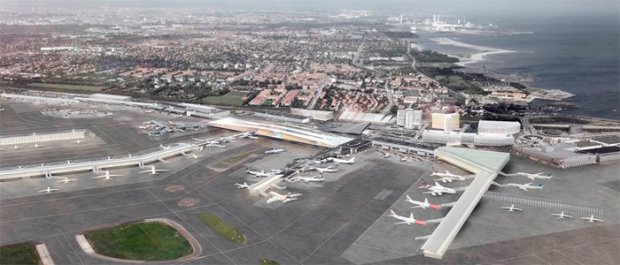Copenhagen Airport to invest millions to reduce costs for airlines

On Wednesday, Copenhagen Airports A/S will present an investment package aimed at reducing costs for airlines and making the airport even more attractive. At the same time, the airport wants to get more Danes flying on its domestic routes.
Copenhagen Airport is Denmark’s international hub, connecting the country with the rest of the world. In order to ensure that Denmark also shares in the considerable international growth in aviation, it is therefore vital that Copenhagen Airport is developed and remains an attractive airport for airlines.
In 2016, CPH presented a general expansion plan. In the coming years, the airport will be investing around DKK 20 billion in expanding the airport to create capacity for 40 million passengers and an additional 55,000 take-offs and landings every year.
CPH wants to be even stronger in the competition for future growth. On Wednesday, CPH will therefore be presenting an investment package to maintain the focus on making the airport more attractive and efficient for airlines.
This will be a general investment package that includes the following four elements:
- Investment level increase of around 20%: CPH will be increasing its annual investment in expanding the airport by around 20%, from approx. DKK 1.1 billion in 2016 to DKK 1.3 billion. DKK 200 million will be spent on stepping up construction work to create new capacity for aircraft and passengers as part of the DKK 20 billion plan already announced.
- DKK 500 million for optimisation projects: CPH is ready to double its investments in projects aimed at reducing the airlines’ costs of doing business at Copenhagen Airport, taking those investments to DKK 500 million.
- Investment in domestic traffic: CPH will be strengthening domestic traffic, not least through a DKK 20 million marketing effort that will get more people travelling on domestic routes. At the same time, CPH will be initiating discussions with the authorities to get their assessment of the possibility of introducing a lower airport charge for domestic flights.
- Cross-wind runway to be moved: CPH will be investing DKK 300 million in moving the cross-wind runway until the time comes when it has to be closed completely.
Thomas Woldbye, CEO of Copenhagen Airports A/S, regards the general package as an important and ambitious element in ensuring that Denmark will share in the future growth anticipated at the airport:
“Before Christmas, we presented Expanding CPH, our DKK 20 billion expansion plan. Now we’re launching a plan for how we will make CPH even more attractive and efficient in the shorter term,” says Thomas Woldbye. “Fundamentally, it's about CPH investing in increasing capacity and making it cheaper for airlines to do business here at Copenhagen Airport. This will reduce the airlines’ costs, while at the same time making CPH more attractive in order to bring in new routes and more traffic.”
Thomas Woldbye stresses that CPH’s investments will be brought forward and increased significantly in the coming years within the DKK 20 billion general plan:
“In recent years, we’ve been investing around DKK 1 billion a year in expanding and developing CPH. We’re now increasing this level by around 20% to approx. DKK 1.3 billion a year,” says Thomas Woldbye. “At the same time, we’re investing in reducing the airlines’ costs of doing business at Copenhagen Airport. We want to be an attractive airport, so we’re investing not just in building new capacity, but also in optimising processes, introducing new technology and making things smarter. We’re therefore ready to invest DKK 500 million over the next four years specifically to reduce the airlines’ operational costs at CPH. This money will go on projects that we’re developing in collaboration with the airlines.”
Moving the cross-wind runway
CPH has presented a specific plan to expand the airport so that it can handle up to DKK 40 million passengers a year. An important part of this plan is to build in the area where the cross-windrunway is located in order to create the space needed for developing the airport’s terminals and stands.
“When we launched Expanding CPH, we made it clear that we will be working to reduce the negative consequences of expanding on the cross-wind runway,” says Thomas Woldbye. “Some airlines have expressed concern about the closure of the cross-wind runway in about five years’ time. We’ve therefore decided to invest around DKK 300 million in moving the cross-wind runway so that it can remain operational until such time as it becomes necessary to build on the whole runway. This is a major investment, but one we’re willing to make for our customers. This will reduce the negative consequences to a minimum.”
However, we will need to fully close the moved cross-wind runway when the airport will be handling 40 million passengers a year.
Domestic traffic especially important
An especially important area for Copenhagen Airport is domestic traffic:
“Domestic flights are helping to connect up Denmark, and domestic traffic is strengthening CPH as a hub,” says Thomas Woldbye. “Passengers should have easy and frequent connections between all parts of the country, and we can definitely see the potential in improving domestic traffic. There are a lot of people who could benefit from flying between different parts of the country but are not doing so today. One of the reasons for this is that many of them are not sufficiently aware of the possibilities, so we see it as a natural assignment for us to work with the airlines to better promote domestic traffic. From this year, we’ll therefore be setting aside DKK 20 million to market domestic air travel,” says Thomas Woldbye.
As well as the marketing efforts, CPH will also be asking the authorities to review whether from the next charges period, beginning in 2019, it might be possible to introduce a lower airport charge for domestic flights, which is not currently possible with the applicable EU rules.


